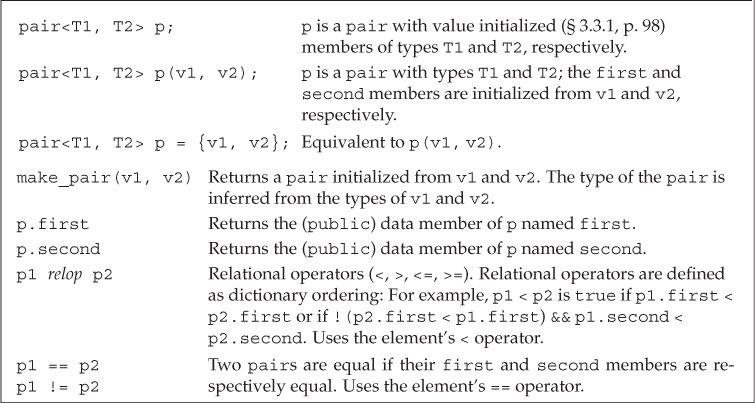11.2.3. The pair Type
Before we look at the operations on associative containers, we need to know about the library type named pair
, which is defined in the utility header.
A pair holds two data members. Like the containers, pair is a template from which we generate specific types. We must supply two type names when we create a pair. The data members of the pair have the corresponding types. There is no requirement that the two types be the same:
pair<string, string> anon; // holds two strings
pair<string, size_t> word_count; // holds a string and an size_t
pair<string, vector<int>> line; // holds string and vector<int>
The default pair constructor value initializes (§ 3.3.1, p. 98) the data members. Thus, anon is a pair of two empty strings, and line holds an empty string and an empty vector. The size_t value in word_count gets the value 0, and the string member is initialized to the empty string.
We can also provide initializers for each member:
pair<string, string> author{"James", "Joyce"};
creates a pair named author, initialized with the values "James" and "Joyce".
Unlike other library types, the data members of pair are public (§ 7.2, p. 268). These members are named first and second, respectively. We access these members using the normal member access notation (§ 1.5.2, p. 23), as, for example, we did in the output statement of our word-counting program on page 421:
// print the results
cout << w.first << " occurs " << w.second
<< ((w.second > 1) ? " times" : " time") << endl;
Here, w is a reference to an element in a map. Elements in a map are pairs. In this statement we print the first member of the element, which is the key, followed by the second member, which is the counter. The library defines only a limited number of operations on pairs, which are listed in Table 11.2.
Table 11.2. Operations on pairs

A Function to Create pair Objects
Imagine we have a function that needs to return a pair. Under the new standard we can list initialize the return value (§ 6.3.2, p. 226):
pair<string, int>
process(vector<string> &v)
{
// process v
if (!v.empty())
return {v.back(), v.back().size()}; // list initialize
else
return pair<string, int>(); // explicitly constructed return value
}
If v isn’t empty, we return a pair composed of the last string in v and the size of that string. Otherwise, we explicitly construct and return an empty pair.
Under earlier versions of C++, we couldn’t use braced initializers to return a type like pair. Instead, we might have written both returns to explicitly construct the return value:
if (!v.empty())
return pair<string, int>(v.back(), v.back().size());
Alternatively, we could have used make_pair to generate a new pair of the appropriate type from its two arguments:
if (!v.empty())
return make_pair(v.back(), v.back().size());
Exercises Section 11.2.3
Exercise 11.12: Write a program to read a sequence of strings and ints, storing each into a pair. Store the pairs in a vector.
Exercise 11.13: There are at least three ways to create the pairs in the program for the previous exercise. Write three versions of that program, creating the pairs in each way. Explain which form you think is easiest to write and understand, and why.
Exercise 11.14: Extend the map of children to their family name that you wrote for the exercises in § 11.2.1 (p. 424) by having the vector store a pair that holds a child’s name and birthday.
